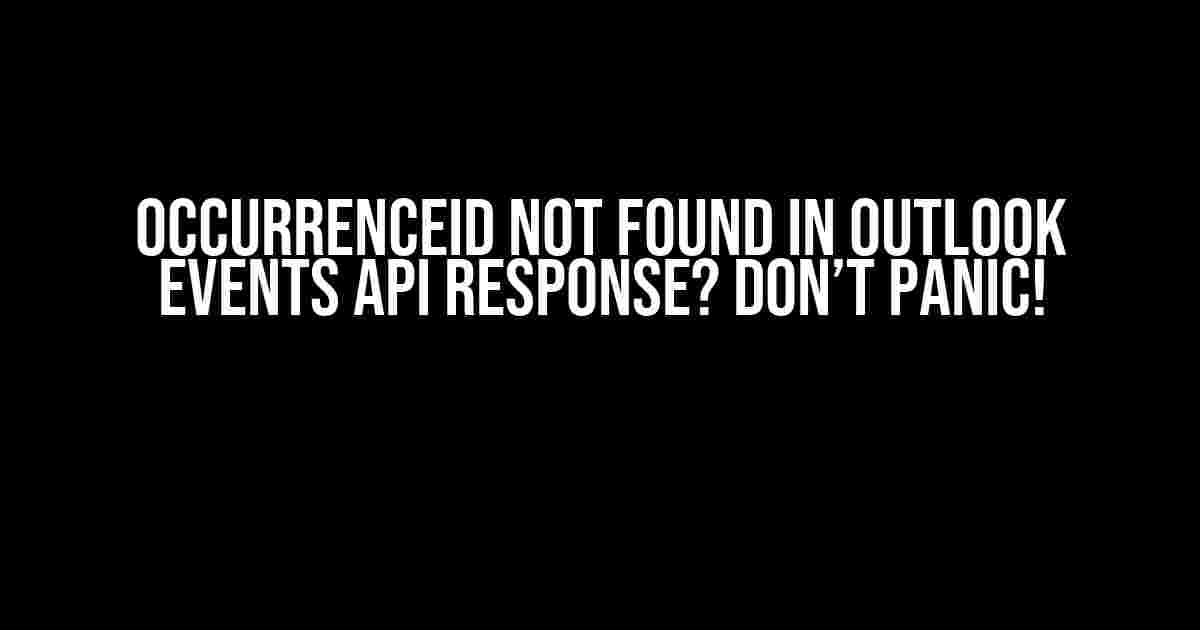Are you scratching your head, wondering why the occurrenceId is missing from your Outlook Events API response? You’re not alone! In this article, we’ll delve into the world of Microsoft Graph API, explore the possible reasons behind this issue, and provide you with actionable solutions to get you back on track.
What is the OccurrenceId in Outlook Events API?
Before we dive into the problem, let’s quickly cover the basics. The occurrenceId is a unique identifier for a specific occurrence of a recurring event in the Outlook calendar. It’s an essential property that helps you differentiate between individual instances of a recurring event. In the Outlook Events API, the occurrenceId is typically returned in the response when you retrieve a list of events or a single event.
Why is OccurrenceId Important?
The occurrenceId plays a crucial role in managing recurring events efficiently. With this identifier, you can:
- Update or cancel a single occurrence of a recurring event without affecting other instances.
- Retrieve the exact instance of a recurring event, enabling you to fetch its specific details.
- Perform actions on individual occurrences, such as moving or copying them to a different calendar.
Now that we’ve established the significance of occurrenceId, let’s examine the possible reasons why it might be missing from your API response.
Possible Reasons for OccurrenceId Not Being Returned
Take a deep breath, and let’s explore the potential causes behind this issue:
1. Incorrect API Endpoint or Request
Double-check your API request and endpoint. Ensure you’re using the correct endpoint and request type (GET, POST, PATCH, etc.). For example, when retrieving a list of events, use the following endpoint:
https://graph.microsoft.com/v1.0/me/events2. Insufficient Permissions or Authentication
Verify that you have the necessary permissions and authentication to access the Outlook Events API. Make sure you have the correct scopes and permissions in your Azure AD application. You can check the Microsoft Graph API documentation for the required permissions.
3. API Version or Beta Features
The occurrenceId might not be available in certain API versions or beta features. Ensure you’re using a stable API version that supports the occurrenceId property.
4. Recurring Event Expansion
When retrieving a recurring event, the occurrenceId might not be returned by default. You need to expand the recurring event using the `$expand` parameter in your API request. For example:
https://graph.microsoft.com/v1.0/me/events?$expand=instances5. API Response Pagination
If the API response is paginated, the occurrenceId might not be returned in the initial response. You need to fetch the next page of results using the `@odata.nextLink` property.
Troubleshooting Steps
Now that we’ve identified the potential causes, let’s walk through some troubleshooting steps to resolve the issue:
- Check API request and endpoint: Verify your API request and endpoint are correct, and you’re using the right HTTP method.
- Review permissions and authentication: Ensure you have the necessary permissions and authentication to access the Outlook Events API.
- Update API version or beta features: If you’re using a beta feature or an older API version, try updating to a stable version that supports the occurrenceId property.
- Expand recurring events: Use the `$expand` parameter to expand recurring events and retrieve the occurrenceId.
- Fetch next page of results: If the API response is paginated, fetch the next page of results using the `@odata.nextLink` property.
- Check API response structure: Verify the API response structure and ensure the occurrenceId property is not nested or hidden within another property.
Working with OccurrenceId in Outlook Events API
Once you’ve resolved the issue and obtained the occurrenceId, here are some tips on working with it effectively:
Retrieving a Single Occurrence
To retrieve a single occurrence of a recurring event, use the following endpoint:
https://graph.microsoft.com/v1.0/me/events/{eventId}/instances/{occurrenceId}Replace `{eventId}` with the ID of the recurring event and `{occurrenceId}` with the ID of the specific occurrence you want to retrieve.
Updating or Canceling a Single Occurrence
To update or cancel a single occurrence of a recurring event, use the following endpoint:
PATCH https://graph.microsoft.com/v1.0/me/events/{eventId}/instances/{occurrenceId}In the request body, include the updated properties or the `cancelled` property set to `true`.
Conclusion
The occurrenceId is a crucial property in the Outlook Events API, and its absence can hinder your application’s functionality. By following the troubleshooting steps and understanding the possible reasons behind its disappearance, you can resolve the issue and work effectively with the occurrenceId.
Remember to:
- Verify your API request and endpoint.
- Ensure you have the necessary permissions and authentication.
- Update your API version or beta features, if necessary.
- Expand recurring events using the `$expand` parameter.
- Fetch next page of results, if the API response is paginated.
With the occurrenceId in hand, you can efficiently manage recurring events and create a seamless user experience in your application.
| Troubleshooting Step | Possible Solution |
|---|---|
| Check API request and endpoint | Verify endpoint and request type |
| Review permissions and authentication | Check Azure AD application permissions and authentication |
| Update API version or beta features | Update to a stable API version that supports occurrenceId |
| Expand recurring events | Use $expand parameter to retrieve occurrenceId |
| Fetch next page of results | Use @odata.nextLink property to fetch next page |
By following this comprehensive guide, you’ll be well-equipped to handle the occurrenceId and create a robust application that integrates seamlessly with the Outlook Events API.
Frequently Asked Question
Are you stuck with the Outlook Events API and can’t find the occurrenceId in the response? Don’t worry, we’ve got you covered! Check out these frequently asked questions to resolve the issue.
What is occurrenceId and why is it important in Outlook Events API?
OccurrenceId is a unique identifier for a specific instance of a recurring event in Outlook. It’s essential to identify a particular occurrence of a recurring event, as it helps you to manage and update the event correctly. Without occurrenceId, you might end up updating the wrong instance of the event.
Why is occurrenceId not returned in the Outlook Events API response?
OccurrenceId is not returned by default in the Outlook Events API response. You need to specifically request it by including the `$select` parameter in your API request and specifying `occurrenceId` as one of the properties to retrieve.
How do I request occurrenceId in the Outlook Events API?
To request occurrenceId, you need to add the `$select` parameter to your API request and specify `occurrenceId` as one of the properties to retrieve. For example, your request should look like this: `https://graph.microsoft.com/v1.0/me/events?$select=subject,body,occurrenceId`. This will return the occurrenceId along with other event properties.
What if I’m still not getting occurrenceId in the API response?
If you’re not getting occurrenceId even after including the `$select` parameter, check if you’re using the correct API endpoint and request headers. Also, ensure that you have the necessary permissions to access the occurrenceId property. If you’re still facing issues, try debugging your API request using tools like Fiddler or Postman.
Can I use occurrenceId to update or delete a specific instance of a recurring event?
Yes, you can use occurrenceId to update or delete a specific instance of a recurring event. To do this, you need to make a PATCH or DELETE request to the Outlook Events API, specifying the occurrenceId in the request URL. For example, to update an event instance, your request URL should look like this: `https://graph.microsoft.com/v1.0/me/events/{eventId}/instances/{occurrenceId}`.


